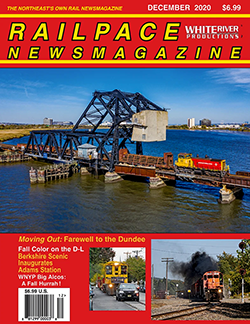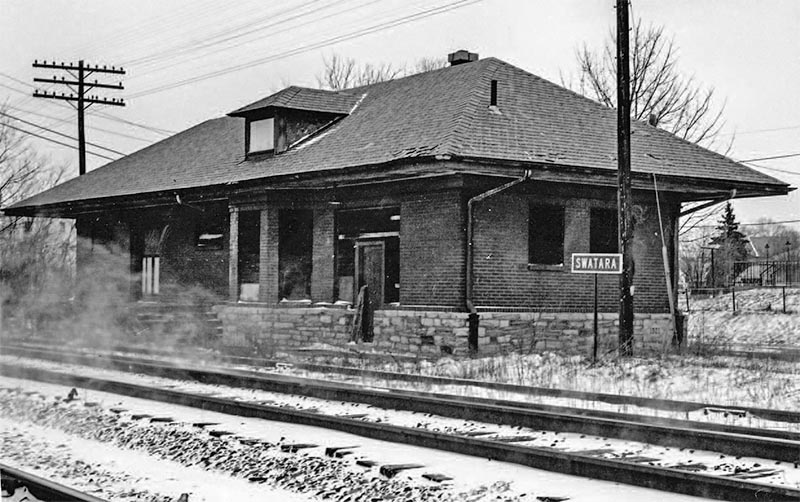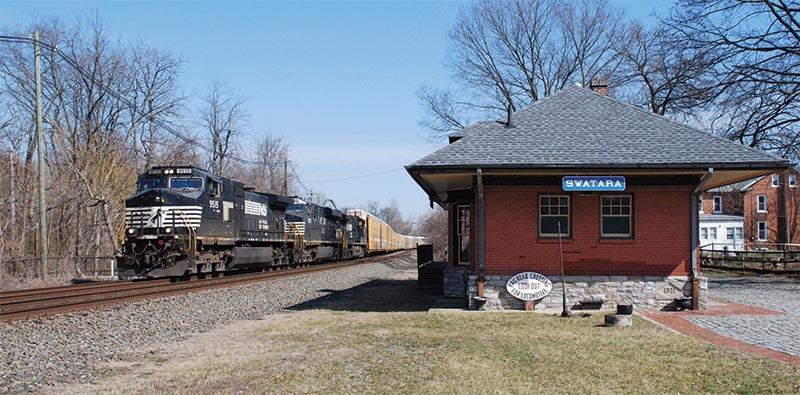 By Thom Horvath/photos as noted
By Thom Horvath/photos as noted
What stories Swatara’s depot could tell of all that it has seen over the years. There was the Curry & Son’s Flour Mill Fire in 1914, P&R’s “Embroidery Joe”, a 1953 Reading freight train derailment, and watching passenger train service end in 1963. From the early days of the Philadelphia & Reading Railroad to Norfolk Southern, this Pennsylvania station has seen it all.
Early History
May 30, 1914 would be a good starting point for the first notable event in the community of Swatara Station. That would be the date when Curry & Son’s Flour Mill, Grain Elevator and Coal Yards were destroyed by an immense fire. Losses included 3,000 bushels of wheat, milling machinery and two P&R boxcars. Piles of new railroad ties adjacent to the tracks also caught fire and burned. The estimated loss amounted to $75,000. The local farming community also suffered, as this mill was where they sold their products, in addition to purchasing feed and coal.
The fire was discovered in the basement around 3:00 a.m. on Saturday morning. According to a small article in the June 1, 1914, edition of the Allentown Morning Call it was “…believed [to have] originated from a spark from an engine on the Reading Railroad along which it is located.” The intensity of the flames illuminated the sky for miles. People from neighboring towns gathered to watch firemen fight a losing battle with the inferno.
The Hershey and Hummelstown fire companies responded to the fire but were hindered by not having a water supply to effectively fight this blaze. Lebanon’s fire company was also summoned as mutual aid, but did not respond due to a lack of water. Swatara’s water supply was non-existent, which meant water had to be drawn from where it could be found at nearby wells and cisterns. When the fire pumper’s water was exhausted it had to stop until more water became available. It wasn’t until a railroad engine, hauling two tank cars filled with water, arrived several hours later that the fire fighters were able to extinguish the blazes in the mill and coal piles.
Neglect and boarded up windows indicate the depot’s days might be numbered in the late 1970s. Its future did not look very promising when this photo was taken on January 9, 1978. Note that the siding track still existed back then. Photo Courtesy of Hershey-Derry Township Historical Society, Hershey, Pa.
In its aftermath, firemen were able to save P&R’s railroad station and the Swatara Hotel. The mill became a phoenix rising from the ashes and was rebuilt as a two and one-half story structure. Brick used in its construction would come from the first story of the old limestone mill. In 2014, the vacant mill and warehouse complex was renovated and reopened as a restaurant called The Mill.
Grade Crossing Woes
Swatara Station’s grade crossing was described in a 1921 newspaper as “…one of the most dangerous grade crossings on the entire William Penn Highway between Reading and Harrisburg.” It was the responsibility of P&R employees, such as renowned crossing watchman, J.E. Achenbach. His full name was Joseph Embroidery Achenbach, alias “Embroidery Joe.” His fame was derived from a cigar box full of silk threads and his embroidery skills. It was said that every house within a forty mile radius had a table cover, bureau scarf or centerpiece that was the artistic work of “Embroidery Joe.”
Unfortunately “Embroidery Joe’s” days as a P&R watchman at the grade crossing were numbered. On July 11, 1921 Bennett & Randall signed a contract with the P&R to build a subway beneath the tracks at Swatara Station on the William Penn Highway. A “subway” connotation back then meant an underpass for pedestrians, an underground way or passage. This contract was estimated to be worth $150,000. By July 26 work would commence building a detour around the highway crossing.
Lebanon’s The Daily News edition of September 27, 1921, certainly caught the reader’s attention with a headline about “Big Explosion On William Penn Highway.” In an attempt to excavate the grade crossing’s approach, the contractor chose to dynamite it! Sixty holes were drilled to insert the charges, and at 4:30 p.m. on September 26, they were set off by Atlas Powder Company experts. The paper’s description of the explosion noted “…a mighty upheaval [as] there was disrupted 30,000 tons of dirt and stone…” Nearby homes did suffer some broken window panes, but no other major damage was incurred…


